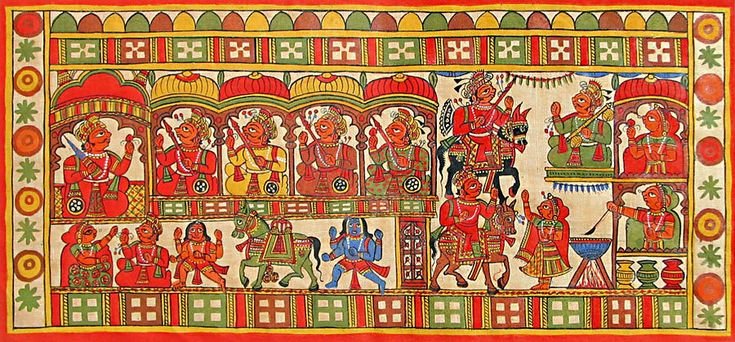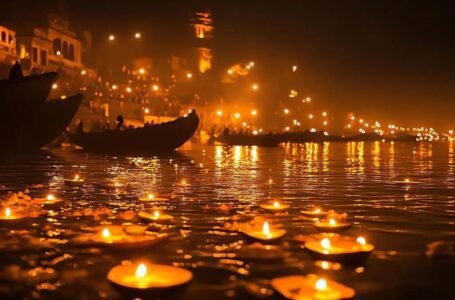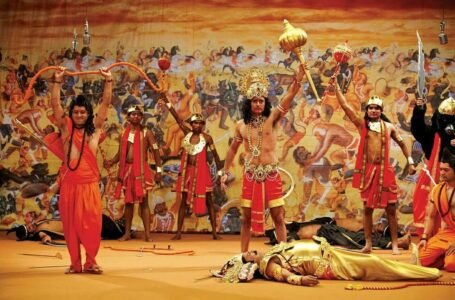Pabuji ki Phad: A Glimpse into Rajasthan’s Rich Folk Tradition Through Scroll Paintings

Nestled in the heart of Rajasthan, one of India’s most vibrant and culturally diverse states, there exists a folk tradition that seamlessly weaves together art, storytelling, and spirituality. Among the many artistic forms that define Rajasthan’s rich heritage, Pabuji ki Phad stands out as a truly unique and remarkable tradition. These elaborate scroll paintings tell the legendary tales of Pabuji, a local deity deeply revered in the region. Once an essential part of folk performances, these intricate paintings have now become rare, practiced only by a few. Still, the story of Pabuji, immortalized through these scrolls, serves as a living symbol of Rajasthan’s rich mythological, historical, and artistic heritage. In this article, we’ll explore the origins, significance, and evolution of Pabuji ki Phad, offering a glimpse into how this vibrant art form continues to embody the essence of Rajasthan’s folk culture.
Pabuji, a revered folk deity of Rajasthan, is believed to have been a Rajput hero who lived in the 14th century. His legend is deeply rooted in the Thar Desert, a central part of Rajasthan’s landscape. Pabuji is celebrated as a warrior, protector, and symbol of bravery. According to local tales, he was born into a humble family, but his courage and unwavering devotion to the divine earned him legendary status. His story revolves around themes of heroism, divine intervention, and the timeless battle between good and evil.
The Phad scroll paintings associated with Pabuji were originally created by the Chipa community, a group of traditional artists in Rajasthan. These scrolls were used as a medium to recount Pabuji’s heroic tales during folk performances. In these performances, the scroll would be unfurled for the audience, while a bhopa—a storyteller and priest—recited the narrative. These performances, known as Pabuji ka Phad or Pabuji ki Katha, were not just a form of entertainment; they were deeply spiritual experiences, blending visual art, music, and oral storytelling. The Phad paintings were more than just artistic depictions; they were sacred objects, allowing the artist to connect with the divine and engage the audience on a spiritual level.
Over time, the Phad paintings have evolved, and while they were once a central part of folk performances, their practice has become rare due to changing social and cultural dynamics. However, the legacy of Pabuji ki Phad still resonates within local communities across Rajasthan, where these scrolls continue to serve as a testament to the state’s rich artistic and spiritual heritage.
Pabuji ki Phad is a large, vertical scroll painting, typically measuring between 10 to 15 feet in length and around 3 to 4 feet in width. Made from cotton or cloth, the canvas often features a light-colored base, allowing the figures to stand out in vibrant contrast. The Phad tells the story of Pabuji through a series of panels, each one depicting different scenes from the mythological tale.
The artistic style of the Phad is striking and distinctive, having evolved over generations. It is characterized by bold, geometric patterns and a bright color palette, dominated by reds, blues, yellows, and greens. The figures are deliberately exaggerated in size and form, with elongated limbs and facial features, giving them a larger-than-life presence. This symbolic style, rather than aiming for realism, is a hallmark of folk art, imbuing the paintings with a sense of mysticism and a connection to the divine.
The composition of a typical Phad is both narrative and symbolic. At the top of the scroll, Pabuji is often depicted on horseback, accompanied by his loyal steed and various attendants and divine figures. The following panels unfold the key moments of the story, such as Pabuji’s epic battles, his divine intervention, and his interactions with characters like his devoted wife, Bhabhri. These scenes are framed by intricate borders, rich with spiritual symbols, animals, and motifs that carry deeper meanings.
Color plays a crucial role in these paintings, not just for aesthetic appeal but for its symbolic significance. Red is used to signify power and energy, while blue represents divinity. The figures are outlined in bold black, making them stand out against the bright background. The detailed borders feature scenes of animals, floral patterns, and elements of nature, all of which enhance the divine and spiritual essence of the story.
The central narrative of Pabuji ki Phad centers around the life of Pabuji, a valiant Rajput warrior, and his deep devotion to the goddess Kali. Born into a humble family, Pabuji is portrayed as the embodiment of the warrior spirit, taking on various challenges and battles to protect his people and uphold justice. His life is intertwined with divine blessings, and he is shown as a protector of the weak and a defender of righteousness.
The story begins with Pabuji’s birth and early life, emphasizing his close connection to his divine mother. As a young man, Pabuji is tasked with defending his people from evil forces. One of his most celebrated feats is his victory over the demon Valkal, who had been wreaking havoc in the local community. The Phad paintings vividly capture this battle, where Pabuji, with divine assistance, triumphs over the demon and restores peace to the region. This victory is not only a physical conquest but also a spiritual triumph, solidifying Pabuji’s status as a deity always present to protect his devotees.
A significant theme in Pabuji’s story is his unwavering devotion to his wife, Bhabhri. She is depicted as a devoted partner, standing by him during times of crisis. The paintings often portray her as a symbol of purity and strength, and her presence underscores the human aspect of this divine myth.
The story of Pabuji reaches its climax with his death and ascension to heaven, where he continues to protect his followers. The final scenes of the Phad show Pabuji’s celestial journey, surrounded by divine beings, ensuring that his spirit remains ever-watchful over the region he once defended.
The bhopa plays a central role in the folk performances that bring Pabuji ki Phad to life. As both the narrator and spiritual leader, the bhopa is tasked with reciting the epic tale of Pabuji while the scroll is slowly unfurled before the audience. But the bhopa’s role goes beyond just telling a story—he acts as a spiritual mediator, calling upon the divine presence of Pabuji through prayer and song.
Typically, the bhopa sings in a traditional Rajasthani folk style, using instruments like the dholak (a drum) and the sarangi (a bowed string instrument). As he recites Pabuji’s story, his words are often accompanied by a ritualistic performance, with the bhopa chanting verses that correspond to the scenes depicted on the Phad. This blend of visual art, oral storytelling, and music creates a truly immersive experience, drawing the audience into the divine world of Pabuji.
The bhopa’s voice is crucial in enhancing the spiritual atmosphere of the performance. His role isn’t just to recount the events but to evoke the emotions and divine essence of the characters, particularly Pabuji, whose presence is believed to be felt through the recitation. The entire performance becomes a communal experience, with the audience actively participating in the ritual by offering prayers and paying homage to the deity.
While Pabuji ki Phad and its associated performances were once a vital part of rural life in Rajasthan, the tradition has faced significant challenges in the modern era. Urbanization, the advent of mass media, and changing cultural preferences have led to the decline of authentic folk performances. The younger generation, less inclined to participate in or appreciate these ancient rituals, has turned to other forms of entertainment, leaving the Pabuji ki Phad tradition in a state of uncertainty. In recent years, some efforts have been made to revive the art form, but these are often overshadowed by modern influences. The original practice of displaying the Phad in front of an audience while the bhopa recites the story has become rare, and the art of creating these intricate scrolls is no longer as widespread as it once was. While some artisans continue to produce Phads, they are now mostly sold as decorative items rather than used in performances. However, there are still pockets of rural Rajasthan where the tradition continues, albeit in a more limited manner. These regions often have a deep connection to the local deities, and the Phad paintings continue to serve as spiritual objects, used in small-scale rituals and festivals.
Pabuji ki Phad is a living testament to the richness of Rajasthan’s folk tradition, beautifully blending art, mythology, and spirituality. These intricate scroll paintings, which once took center stage in folk performances, are much more than works of art; they are sacred objects deeply rooted in cultural and spiritual significance. Though the tradition of Pabuji ki Phad performances has faded over the years, the paintings still evoke awe and respect for the deity and the artists who have preserved this remarkable legacy.
In the face of modern challenges, efforts to preserve and revive Pabuji ki Phad offer hope for its future. By embracing both tradition and innovation, Rajasthan’s folk heritage can continue to thrive. This ensures that the stories of Pabuji and the art of the Phad will not only be kept alive but will inspire future generations, ensuring that this rich tradition endures for years to come.


